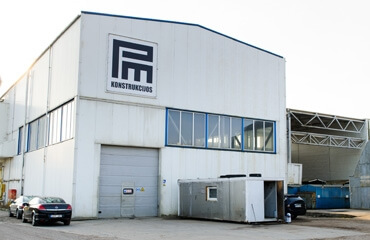Galvanization

Galvanizing services are performed only for our metal constructions. Separately galvanizing service are not provided.
Corrosion causes destruction of hundreds of millions of metal annually, which makes protection against corrosion an important objective.
Metal structures may be used in environments of very low to high corrosion, as well as in soil, freshwater or saltwater conditions. Under such conditions, foci of corrosion start developing, metal starts showing signs of degradation, leading to reduction of the mass of structure. Consequences: reduced resistance of the metal structure against mechanical impact. This means that undesirable consequences may be avoided by anti-corrosive measures. Galvanization (metal coating with zinc layer for prevention of metal corrosion) is one of the most popular and cheapest methods for metal protection.
This is an effective and ecological method for protection of metal against corrosion, extending service life of metal structures for up to 20 years.
Quality guarantee
Hot dip galvanization is subject to requirements under standard LST EN ISO 1461 Hot dip galvanized coatings on fabricated iron and steel articles. Specifications and test methods. This international standard specified the general properties of coatings and test methods for coatings applied by dipping fabricated iron and steel articles (including certain castings) in a zinc melt (containing no more than 2 % of other metals).
Compliance with technical specifications and testing under the standard ensure high quality of products and any absence of inconsistencies.
Specifications
Hot dip galvanization is performed in 1.6 m wide, 13 m long and 3 m deep bath at the temperature of 450°C - 460°C.
Although galvanization may be performed on different types of steel, the quality of zinc coating (gloss, smoothness, thickness) will be different. This is determined by chemical composition and surface condition of the steel. Such chemical elements as carbon (C), phosphorus (P) and, in particular, silicon (Si) are directly related to the quality of zinc coating. Total maximum content of carbon and silicon in steel shall not exceed 0.5%. Steel with 0.05 ÷ 0.12% silicon content may develop zinc layer leading to increased thickness and roughness, which may result in cracking of metal structures during use. Therefore, hot dip galvanization is the most suitable for steels with silicon content ranging within 0%… 0.03% or 0.12%…0.25%.
Practice shows that steel content is not always exactly the same as specified in the certificate issued. Test galvanization is therefore recommended to avoid any possible inconsistencies.
Preparation of metal structures for galvanizing
Metal structures must be properly prepared before dipping into the molten zinc bath.
After welding, metal structures are subjected to mechanical cleaning in order to remove welding spatter, round sharp edges at the required radius, prepare air and liquid outlets. In particular, enclosed box-shaped structures should be avoided. However, if the design involves such structures, it must also provide indications of the holes.
Please note that all structural elements must be produced from steel of the same grade. Combination of different grades is not recommended, while combination of different groups of steel is prohibited.
Benefits of hot dip galvanization
Galvanization is recommended for metal structures for the following reasons:
- zinc coating is durable and protects the structure from corrosion throughout its service life;
- very low – even close to zero – maintenance costs;
- zinc coating provides uniform coverage of the entire surface of structure even in hard-to-reach areas;
- ambient air conditions do not affect the quality of galvanization;
- zinc coating is resistant to mechanical damage (e.g. during transportation or installation);
- simple quality control procedures;
- galvanized articles may be welded using conventional welding methods.
